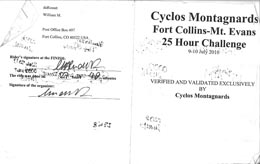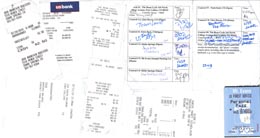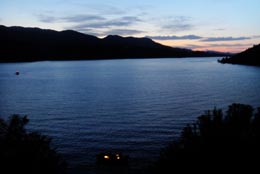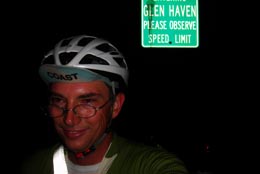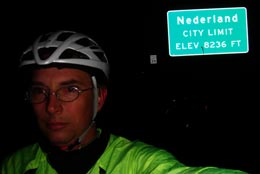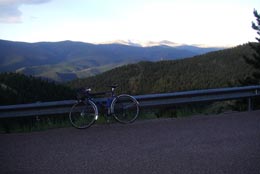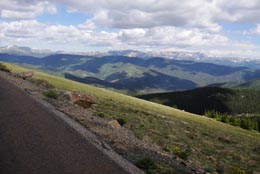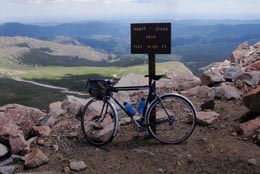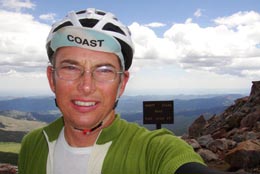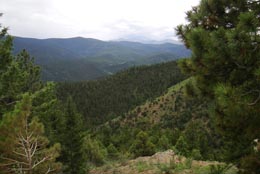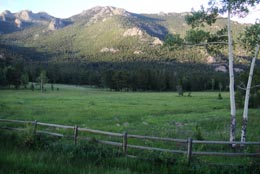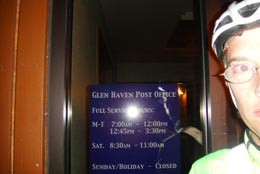|
Ride Report Ride: Colorado Challenge 1: Fort Collins - Mt. Evans via Estes Park and Ward Distance: 450 km (280 miles) Climbing: Ca. 8100 m (26,650 ft) Date: July 9-11, 2010 Time completed: 27:49 hours Rider: Will DeRosset Bicycle: René Herse Randonneur (Challenge Paris-Roubaix 700C x 28 mm tires), with SON20R generator hub and LED headlight. Click here for the route. |
Click on images for large-resolution version. |
CO Challenge No. 1 Mt Evans by Will DeRosset I woke with a start. It was 9:30 a.m., full blazing sun, and gravel stuck to my cheek. My bike sprawled at my feet. I was lying in the middle of a scenic pullout. Picking myself up from the shoulder, I brushed off the sand stuck to my sweaty clothes, shook the disorientation from my mind, savored another Ensure Plus, and remounted my bike. A waterfall of cyclists descended to my left as I settled into my climb. The paved route up Mt. Evans was a switchback away, and I was ready for it at last. I'd finally gotten a half-hour of rest.... The Mt. Evans Challenge concept was simple and inspiring—ride from Fort Collins, through the Devils Gulch switchbacks and Estes Park, to Idaho Springs via the Peak to Peak Highway and Oh My God Road, then climb the highest paved road in North America to the Mt. Evans summit. Return by the same route. There was only one variable at play—the City of Blackhawk had banned cycling on its paved roads, and I'd had to map a detour around the ban. From my prior efforts and mapping research, I knew the route was 450 Km (280 mi) long and around 8,100 m (26,650 ft) of total ascent, or about the same amount of climbing as from sea level to the summit of Annapurna, only without the frostbite potential. Even though the route only tops out at a touch over 4300 m (14,100 ft), afternoons are no time to be above treeline on the Front Range, so I planned to be at the Mt. Evans summit by noon. Working backward, I decided to start from Fort Collins around dusk, ride the Peak to Peak overnight, arrive at Idaho Springs around dawn, and climb Mt. Evans in a bit over four hours. My itinerary established, I contacted the Cyclos Montagnards. They approved the route and my proposed schedule, and I was set for an evening start on Friday, July 9. I'd made it to the top of Mt. Evans twice last year, but never completed the return trip. The first try ended when my newly-installed bottom bracket came loose on the long climb and I lacked the tools to tighten it. The second attempt ended when I got sick and spent the next three days with the flu. In each case, I ended up riding overnight to the summit of Mt. Evans, only to end my ride in a deli on Miner St, over a hundred miles from home. For my third attempt, I committed to finish regardless of my time. Neither the RUSA rules nor the Cyclos Montagnards challenge rules allow personalized outside support. I'd be riding for over 24 hours. I needed to carry clothing for 5-33ºC (40-90ºF) temperatures and afternoon thunderstorms. There were going to be no open stores between Fort Collins and Idaho Springs given my evening start time; consequently, I also needed to carry sufficient water and food to travel overnight. I'd spend a full night on the road and a few hours the next day riding in the dark. I'd need reliable lights with over 12 hours of full brightness. Finally, most of the route was well-paved with smooth asphalt, but Virginia Canyon Road was unpaved, and the final fifteen miles of the road up Mt. Evans was badly frost-heaved and poorly patched. Wider tires with supple casings would mute the shock and reduce my fatigue. I chose to ride my René Herse randonneuring bicycle. It is well-suited to paved-road unsupported riding with 28 mm clincher tires, integrated generator-powered lights, full fenders, and a steering geometry optimized for a loaded front handlebar bag. Fenders are perhaps not absolutely required here on the semi-arid Front Range, but the thought of spending over a day in the same wet pair of shorts if I were caught in an evening thunderstorm wasn't appealing, and I wasn't about to add another item of clothing to my already long list of spares. I signed in at The Bean Cycle at 8:20 p.m. on Friday night. I bought an iced coffee, drank it, and moved past the sidewalk throng, between the parked cars, and into the deepening gloom. I was underway on my third attempt on the Cyclos Montagnards Ft. Collins-Mt. Evans Challenge. My handlebar bag was stuffed full, with two supplemental waterbottles, three bottles of Ensure Plus, three cans of coffee, ten cereal bars, warm clothes, a windbreaker, a toothbrush, toilet paper, sunscreen, and spares for the bike. The air was humid as I cycled through town toward Horsetooth Reservoir. I half-expected to hear cicadas and see fireflies given this East-Coast evening on the Front Range. As I rode west into the hogbacks that separate Fort Collins from Horsetooth Reservoir, the last evening light was fading from the water. There would be no moon tonight—an unfortunate condition. Last year I'd timed both my attempts near a full moon. The only company I'd have tonight were the planets and the stars swinging overhead. I paused to take a photo and don my long sleeves and legwarmers. |
Horsetooth at dusk
|
Passing Masonville, traversing Eden Valley, and merging onto US 34 for my climb to Drake, I pedaled steadily into the night. I was fatigued from the week's work, and I hadn't taken a nap before the ride. Drake and Glen Haven passed beneath my wheels. After a short midnight phone call to my wife, and a long search for an ATM kiosk, I was back on the road to Allenspark and Nederland. I had ridden this segment exactly as fast as I had the year prior. |
|
Time passes strangely without a moon. Overnight my fatigue built, and I was riding noticeably slower than I expected. I was eating well, regularly fishing through the nosebag for yet another cereal bar, Ensure Plus (mmmm, oily) or canned coffee (another culinary delight), but I just couldn't cut through the mental fog, and the three bright panes of light my headlamp projected onto the pavement dragged on my eyelids. My headlight was bright enough that oncoming cars flashed me. I'd swapped front lights since last year, and the newer one had a brighter emitter. Cutting generator power with the stem-mounted switch left me riding by my standlights. The standlight was adequate for climbing and for the flats, but I wished for a “low” beam setting so I could cut the full brightness of the light for oncoming traffic while still illuminating my way on moderate-speed descents. |
|
Climbing out of Nederland toward Rollinsville, I was briefly chased by three partygoers straggling back from their revels. One called out, “That's my bike! Gimme my bike!” and the others, laughing, staggered after me. I silently left them behind, and spent the next climbs formulating an appropriate response. The route greyed, the treeline became visible, and dawn began as I approached Blackhawk and Central City, the entrée to Virginia Canyon Road (Oh My God Road). Blackhawk had recently banned bicycle traffic from its paved roads, so I'd mapped an alternate route. Unfortunately, it was gated a mile or so in. After trying a couple of other dead-end streets, I was obliged to turn back and walk the half-mile or so through Blackhawk to Central City. After this refreshing adventure in routefinding, I climbed through Central City and descended Virginia Canyon Road (Oh My God Road). This route, switchbacked into the mountainside, affords clear and stunning views of the Mt. Evans massif. This year, Oh My God Road was badly washboarded, and I found myself wishing for wider tires as I tucked down and balanced on the pedals to isolate myself from the punishing road shock. |
|
I rolled into Idaho Springs, got a café au lait, checked in with Susan, refilled my water bottles, dumped the pile of food wrappers I'd accumulated overnight, and began the 30 mi, 7,000 ft climb to the Mt. Evans summit. As the sun ranged higher and the altitude mounted, my head became heavier. Tracking steadily was a chore. Last year, I'd derived energy from this stretch, climbing steadily into the rising day, waving to the Triple Bypass riders descending from their first climb, and knowing I'd get every foot of elevation back on the descent. Not today. I was falling far behind schedule, and I'd not planned for a mid-ride nap. However, safety came first, and I really didn't have much choice if I was going to continue. I started looking for a quiet place to stop. A scenic overlook presented itself. No shade, but it was off of the road. I pulled out. I dropped my bike at my feet, took half a caffeine tablet, set my watch, lay down on the flat and welcoming gravel, and closed my eyes. |
Heading up Mt. Evans |
I woke after half an hour. It was 9:30 a.m. I'd slept through my fifteen-minute alarm. I tossed back an Ensure Plus and was on my way a few moments later. I should have stopped earlier, and I wondered how much time I'd lost in the mental fugue between Nederland and this overlook. Sportif cyclists descended to my left as I settled back into the climb. I checked in at the Mt. Evans fee station, paid for my three-day pass, and received a purple stem-mounted party bracelet and receipt stub for my fee. I was off, climbing slowly into the alpine zone. The frost-heaved and plow-damaged pavement was no issue at my climbing speed, but I noted the best lines for the descent. At least the road was clean. I summited a bit after noon, 15h48 after my start. My elapsed time was about an hour slower than my first attempt, the same as my second effort, and an hour and a half slower than my schedule. I didn't feel any jubilation at the top despite the montane vista below me, but, in contrast to my prior efforts, I was ready for the return trip. The bicycle was operating well. I was tired, but was in neither pain nor distress, and I knew I'd finish the route, though well outside of my original schedule unless I found some fount of energy within. |
|
I zipped up my windbreaker, ate a cereal bar, drank my last coffee and released myself to gravity at last. I've had a year riding the René Herse, and have developed complete confidence in its handling. I stayed off the brakes except when negotiating my way around flatlander drivers, and tucked into the machine. The descent was bruisingly rough on 28 mm tires due to the damaged pavement, but the roadway designers had done their work well, and I rolled into Idaho Springs about 50 minutes after I'd topped out at the Mt. Evans summit parking lot. |
All that's left is the return ride! |
I was riding to the finish now. I stopped at a deli, used their facilities, left a check-in message for Susan, my wife, and got a sandwich to go. Winding my way back to Central City went slowly, and I had ample time to marvel at the interplay of sun, cloud, and shadow on the mountainsides below while working on my lunch and climbing the unpaved road. I reprised my walk through Blackhawk, inventing variations on, “I'll never spend a dime here as long as they discriminate against me.” This pleasant diversion occupied my mind through most of the climb to Rollinsville.
|
|
Despite my efforts to keep my speed up, the effects of the miles and extended time at altitude had accumulated in my legs and I was either standing listlessly, grimly pushing a too-high gear, or twiddling every climb. Consequently, my hands and seat were taking more than their share of my weight, and I'd pay that toll as the day lengthened. I was also chilled, and wore my leggings even in the midday heat. The ride to Nederland was a low point, in spite of the unrelentingly beautiful terrain, well-maintained road, and sunny afternoon. At Nederland, I bought a few cereal bars and filled my waterbottles. The late afternoon sun rendered the pines and meadows a golden green, and a playful breeze stirred the aspens to life, changing direction with the orientation of the road cuts. I wasn't moving fast, and I was losing time, unable to push faster, but the heat of the day had broken, and I was recovering my joy at being out on the bicycle. The ride was beautiful again. Topping out at Windy Pass, I waited for an elk cow and her spotted calf to cross the road, then tucked down for the extended descent to Estes Park. |
|
At Estes Park, I called Susan and stopped for a brief fast-food meal. I ate my bag o' grease on the parking lot patio, sharing the delectable experience with several sunburnt and overstimulated children swarming the concrete furniture and their drawn, wheedling parents. I took my last half-tablet of caffeine and pushed off, creeping up Wondervue, past the whitewashed Stanley Hotel, and aimed for the big descents to the plains. I'd originally planned to be done by around nightfall, and the descent to Drake on the always-pleasant Devils Gulch Road went slower than expected. By the time I got to US 34, the weekend down-canyon traffic had picked up, and I did not relish that section of occasionally shoulderless descent in the dark. Turning back onto CR 22H was a relief. The return to Masonville was anticlimatic, and, without the moon to light the landscape, time passed slowly as I painfully ground up the last three hills. Coming over the top of South Dam, Fort Collins lay below me, lit in an orange-tinged lume. I descended, found my way downtown, and got a receipt at an ATM, as my finish control had closed at 10 p.m. My total elapsed time was 27h49, not quite three hours slower than my schedule. I rode home. The only sleep I'd had in over 42 hours had been that precious half-hour nap on the side of the road, and I was ready for a rest. Notes: The Mt. Evans Challenge route is now available as an RUSA Permanent to RUSA members. It is Permanent 855, the Mt. Evans Grimpeur. More information is available at http://www.RUSA.org I'd make three significant changes to my ride planning next time. First, I'd take a nap before the start. For the first time in my seven years' randonneuring, I had trouble with fatigue. Second, I'd hunt down a well-matched friend with whom to share the challenge. The route is climbing-intensive enough that pacelining won't help much, but the psychological support would make the overnight easier. Third, I'd plan the challenge to coincide with a full or waning gibbous moon. The weather was completely cooperative. High temperatures were in the upper 80sºF, and lows were around 42ºF. I suffered through no sustained headwinds, and I got rained on for less than one minute total. I carried an ultralight windbreaker, arm warmers, leg warmers, an ear band, rain mitts, and toe covers in addition to my bib shorts, undershirt, wool jersey, cycling cap, helmet, and track mitts. I ended up being cold on the overnight descents. In contrast, the last two times I rode the route I brought my goretex racing cape instead of the windbreaker, and was sweaty on the overnight climbs. I chose to use bib shorts on an overnight ride for the first time since 2005, and I was reminded that their comfort advantage was small relative to their time-consuming inconvenience at stops. I didn't bring a pair of long-finger glove liners this time, and would have preferred to have had a pair with me in addition to the rain shells, which were clammy. The bicycle performed nearly flawlessly. I'd had no mechanical difficulties, the Challenge 28 mm tires were silent on the climbs and sang on the descents, the front-loaded luggage was fully functional and let me eat, navigate, and change clothes on the bike, and the gearing was well-suited to my strength and the terrain. I had no flat tires. I switched from Ergo shifters to indexed downtube shifters since my first attempt, and I have found that downtube shifters provide helpful tactile awareness of derailleur position in the night. I also changed front lights, and the inverted Edelux lamp mounts directly to the rack, two inches lower and about two inches further back than the other one did on its mounting bracket. As a result, the right tire casts a distracting shadow and limits descending speeds on right-hand switchbacks. Rene Herse's Mike Kone has revised his front racks to account for the inverted Edelux position since my rack was built. I'll get the lighting arm moved this winter. I jogged through Blackhawk in my stocking feet. If their bicycle ban remains in place the next time I ride this route, I'll use walkable shoes instead of my racing cleats for the ride. |
|
|
|
|
|
|
|
|
|
